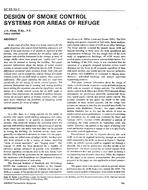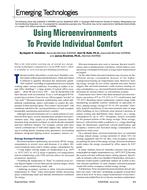Track: Building Life Safety Systems
Sponsor: 2.3 Gaseous Air Contaminants and Gas Contaminant Removal Equipment, 2.4 Particulate Air Contaminants and Particulate Contaminant Removal Equipment
Chair: Russell Taylor, Ph.D., Member, United Technologies Research Center, East Hartford, CT
This session provides DHS and DOD perspectives on the need for biological and chemical agent threat detection in commercial buildings. Possible threat scenarios are discussed along with the potential for low cost sensors integrated with existing life safety systems to detect the presence of those threats. Building responses through the HVAC systems and the effectiveness of those responses for mitigating the threat in a specific building case study is discussed. Finally, there is a discussion of efforts to model threat detection and response scenarios in broad classes of commercial buildings.
1. Biological and Chemical Threat Detection in Commercial Buildings: A DHS Perspective
Matthew Davenport, Department of Homeland Security, Washington, DC
High profile targets for biological and chemical attack are relatively easy to identify and thus provide appropriate protection. However, a low but real risk is present for many other commercial buildings, particularly those that have large numbers of occupants (so called soft targets). The low probability of such an event, combined with the high cost of sensors capable of confirming the presence of hazardous agents are problematic for widespread adoption. Consequently, DHS is studying technology that could both detect hazardous agents in buildings and improve the performance of existing life safety systems, at minimal additional cost to the building owner.
2. The Need for Low Cost Biological Agent Detection in Buildings: A DOD Perspective
Patricia Buckley, US Army ECBC (Edgewood Chemical Biological Center), Parkville, MD
This presentation provides an overview of the need and prospects for low cost biological and chemical agent detection from the perspective of the DOD.
3. A Decision Support Framework for Automated Building Systems Response to Mitigate Occupant and Facility Impacts from Chemical and Biological Agents
Angela Waterworth, Pacific Northwest National Labs, Richland, WA
A methodology to determine automated heating, ventilation and air conditioning (HVAC) system and building response mitigations for bio-aerosol or chemical threats in commercial buildings is under development at Pacific Northwest National Laboratory (PNNL). Models of indoor contaminant dispersion are used to identify and respond to threats based on distributed sensor data. Model scenario verification will be performed; however, validation will be limited to agent surrogates.
4. A Study of Hazardous Agent Propagation in an Office Building to Evaluate HVAC Threat Mitigation Strategies
Russell Taylor, Ph.D., BEMP, Member, United Technologies Research Center, East Hartford, CT
Computer flow network models and experiment are used to create a release of a chemical/biological surrogate agent and understand its propagation in a commercial office building. Manipulation of the building HVAC system is used to mitigate the spread of the surrogate and limits its possible effects on building occupants.
Presented: June 26, 2017, 8:00-9:30 AM
Run Time: 90 min.
This is a zip file that consists of PowerPoint slides synchronized with the audio-recording of the speaker (recorded presentation), PDF files of the slides, and audio only (mp3) for each presentation.
Citation: ASHRAE Seminar Recordings, 2017 ASHRAE Annual Conference, Long Beach , CA
Product Details
- Published:
- 2017
- Units of Measure:
- Dual
- File Size:
- 1 file , 99 MB
- Product Code(s):
- D-LB17Sem22


